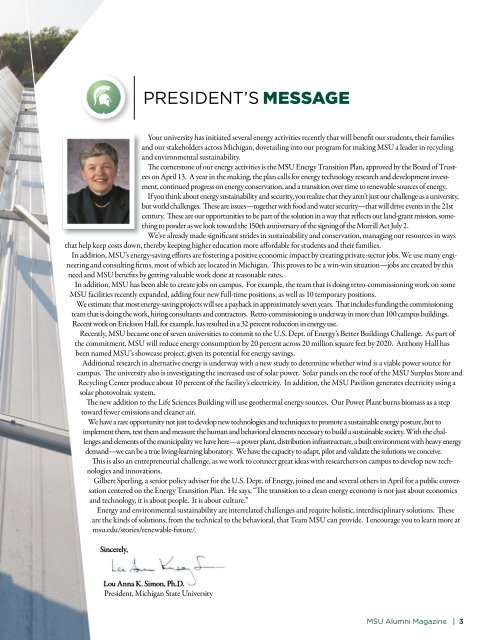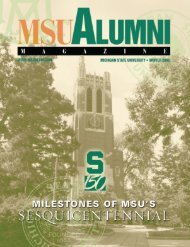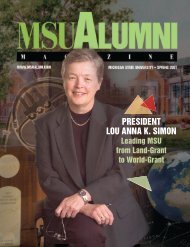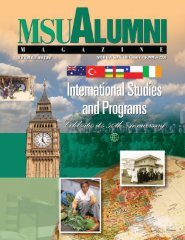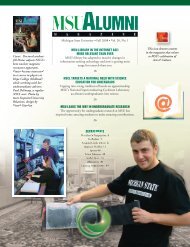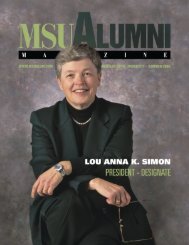Raving fans wear Spartan jewelry - MSU Alumni Association ...
Raving fans wear Spartan jewelry - MSU Alumni Association ...
Raving fans wear Spartan jewelry - MSU Alumni Association ...
Create successful ePaper yourself
Turn your PDF publications into a flip-book with our unique Google optimized e-Paper software.
PRESIDENT’S MESSAGE<br />
Your university has initiated several energy activities recently that will benefit our students, their families<br />
and our stakeholders across Michigan, dovetailing into our program for making <strong>MSU</strong> a leader in recycling<br />
and environmental sustainability.<br />
The cornerstone of our energy activities is the <strong>MSU</strong> Energy Transition Plan, approved by the Board of Trust-<br />
ees on April 13. A year in the making, the plan calls for energy technology research and development investment,<br />
continued progress on energy conservation, and a transition over time to renewable sources of energy.<br />
If you think about energy sustainability and security, you realize that they aren’t just our challenge as a university,<br />
but world challenges. These are issues—together with food and water security—that will drive events in the 21st<br />
century. These are our opportunities to be part of the solution in a way that reflects our land-grant mission, something<br />
to ponder as we look toward the 150th anniversary of the signing of the Morrill Act July 2.<br />
We’ve already made significant strides in sustainability and conservation, managing our resources in ways<br />
that help keep costs down, thereby keeping higher education more affordable for students and their families.<br />
In addition, <strong>MSU</strong>’s energy-saving efforts are fostering a positive economic impact by creating private-sector jobs. We use many engineering<br />
and consulting firms, most of which are located in Michigan. This proves to be a win-win situation—jobs are created by this<br />
need and <strong>MSU</strong> benefits by getting valuable work done at reasonable rates.<br />
In addition, <strong>MSU</strong> has been able to create jobs on campus. For example, the team that is doing retro-commissioning work on some<br />
<strong>MSU</strong> facilities recently expanded, adding four new full-time positions, as well as 10 temporary positions.<br />
We estimate that most energy-saving projects will see a payback in approximately seven years. That includes funding the commissioning<br />
team that is doing the work, hiring consultants and contractors. Retro-commissioning is underway in more than 100 campus buildings.<br />
Recent work on Erickson Hall, for example, has resulted in a 32 percent reduction in energy use.<br />
Recently, <strong>MSU</strong> became one of seven universities to commit to the U.S. Dept. of Energy’s Better Buildings Challenge. As part of<br />
the commitment, <strong>MSU</strong> will reduce energy consumption by 20 percent across 20 million square feet by 2020. Anthony Hall has<br />
been named <strong>MSU</strong>’s showcase project, given its potential for energy savings.<br />
Additional research in alternative energy is underway with a new study to determine whether wind is a viable power source for<br />
campus. The university also is investigating the increased use of solar power. Solar panels on the roof of the <strong>MSU</strong> Surplus Store and<br />
Recycling Center produce about 10 percent of the facility’s electricity. In addition, the <strong>MSU</strong> Pavilion generates electricity using a<br />
solar photovoltaic system.<br />
The new addition to the Life Sciences Building will use geothermal energy sources. Our Power Plant burns biomass as a step<br />
toward fewer emissions and cleaner air.<br />
We have a rare opportunity not just to develop new technologies and techniques to promote a sustainable energy posture, but to<br />
implement them, test them and measure the human and behavioral elements necessary to build a sustainable society. With the challenges<br />
and elements of the municipality we have here—a power plant, distribution infrastructure, a built environment with heavy energy<br />
demand—we can be a true living-learning laboratory. We have the capacity to adapt, pilot and validate the solutions we conceive.<br />
This is also an entrepreneurial challenge, as we work to connect great ideas with researchers on campus to develop new technologies<br />
and innovations.<br />
Gilbert Sperling, a senior policy adviser for the U.S. Dept. of Energy, joined me and several others in April for a public conversation<br />
centered on the Energy Transition Plan. He says, “The transition to a clean energy economy is not just about economics<br />
and technology, it is about people. It is about culture.”<br />
Energy and environmental sustainability are interrelated challenges and require holistic, interdisciplinary solutions. These<br />
are the kinds of solutions, from the technical to the behavioral, that Team <strong>MSU</strong> can provide. I encourage you to learn more at<br />
msu.edu/stories/renewable-future/.<br />
Sincerely,<br />
Lou Anna K. Simon, Ph.D.<br />
President, Michigan State University<br />
<strong>MSU</strong> <strong>Alumni</strong> Magazine Page | 3


